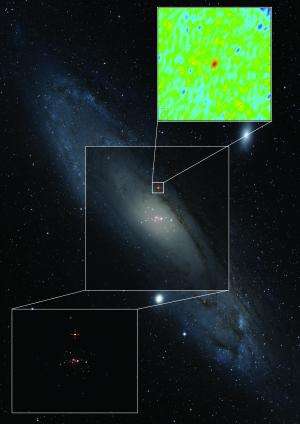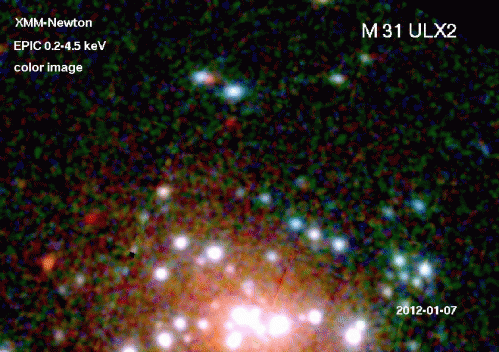A new X-ray source (lower left and detailed in "DUBlack hole missing link Detail 1) detected in the nearby galaxy M31 ("DUBlack hole missing link Overview") was discovered to be associated with an extremely compact radio source (upper right and detailed in "DUBlack hole missing link Detail 2). The coupled X-ray and radio emission point to a stellar-mass black hole accreting above its maximum luminosity threshold. Credit: The main image, showing the optical image of the galaxy, is from the Digitized Sky Survey. The rest of the images (including the X-ray field overlay) were created by Dr James Miller-Jones, of the Curtin University node of the International Centre for Radio Astronomy Research.
For the first time, astronomers have found a microquasar—a black hole devouring material from a companion star—in a galaxy beyond our own Milky Way. The object, pumping out X-rays and bright bursts of radio waves, was found in the Andromeda Galaxy, 2.5 million light-years from Earth.
The discovery, scientists say, gives hope that more such objects may be found in nearby galaxies, providing them with opportunities to make detailed studies that will unravel the mystery of just how these enigmatic powerhouses—and their big brothers—actually work.
In a microquasar like the one newly discovered, a black hole with a mass several times that of the Sun pulls material from its companion star into a rapidly-rotating disk. The disk surrounding the black hole can become so hot it emits X-rays. The disk also propels narrow jets of subatomic particles outward at speeds nearing that of light. The jets generate strong bursts of radio emission.
As the "feeding rate" of the black hole varies, the levels of X-ray and radio emission change, in an interplay whose details are not yet fully understood.
"This is, we think, the same mechanism at work in quasars at the cores of galaxies, where the black holes are millions of times more massive. However, in the smaller systems, things happen much more rapidly, giving us more data to help understand the physics at work," said Matthew Middleton, of the University of Durham in the UK and the Astronomical Institute Anton Pannekoek, in Amsterdam, Netherlands, leader of the research team.
The footage shows the XMM observations, based on individual color images from the observations using 0.2-1 keV as red, 1-2 keV as green and 2-4.5 keV as blue. The bright red object shining up to the NW of the ULX on 2012 Aug 8 is nova M31N 2012-05c (see Henze et al. ATel 4511). Credit: Max-Planck-Institut für extraterrestrische Physik (MPE)
"Understanding how these things work is important, because we think quasars played a big role in redistributing matter and energy when the Universe was very young," Middleton added.
The first microquasar was discovered in 1994, and several have subsequently been found, all within our own Milky Way Galaxy. "Obscuration within our Galaxy makes it difficult to study the disks of these microquasars in the Milky Way, but finding one in a neighboring galaxy means we probably can find many more, thus helping our efforts to better understand their physics," Middleton explained.
The orbiting X-ray observatory XMM-Newton discovered the object, called XMMU J004243.6+412519, on January 15. The Swift and Chandra satellites then observed it regularly for more than eight weeks. The National Science Foundation's Karl G. Jansky Very Large Array (VLA) and Very Long Baseline Array (VLBA), along with the Arcminute Microkelvin Imager Large Array in the United Kingdom, studied the object at radio wavelengths.
The behavior of XMMU J004243.6+412519 at both X-ray and radio wavelengths closely parallels the behavior of previously-discovered microquasars. In addition, the radio observations indicate that the emission from the object is coming from a small region. Even the supersharp radio vision of the VLBA cannot resolve any detail in the object. The VLA detected variations in radio brightness over the course of minutes, indicating that the emitting region is no larger than the distance between the Sun and Jupiter.
"All these indications show that what we have found is, indeed a microquasar," Middleton said. The scientists estimate that the black hole probably is about ten times more massive than the Sun, and that its companion is a middle-sized, rather than a giant, star.
Middleton and his colleagues on an international team published their findings in the scientific journal Nature.
More information: Bright radio emission from an ultraluminous stellar-mass microquasar in M31, by Middleton, MJ, et al is published in Nature, DOI: 10.1038/nature11697
Journal information: Nature
Provided by National Radio Astronomy Observatory
























